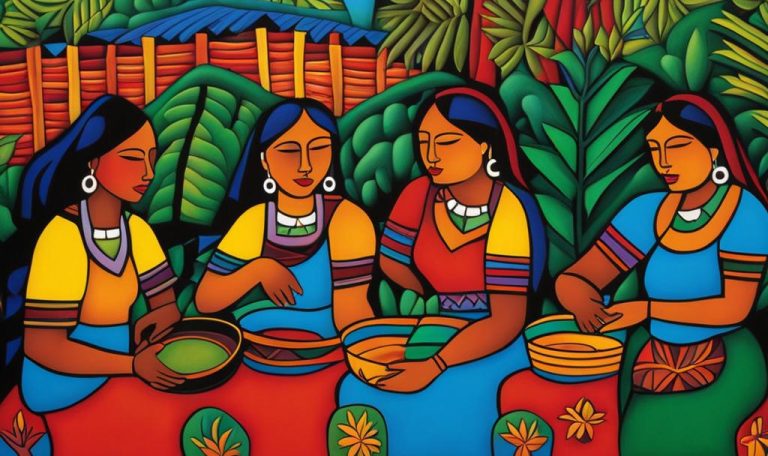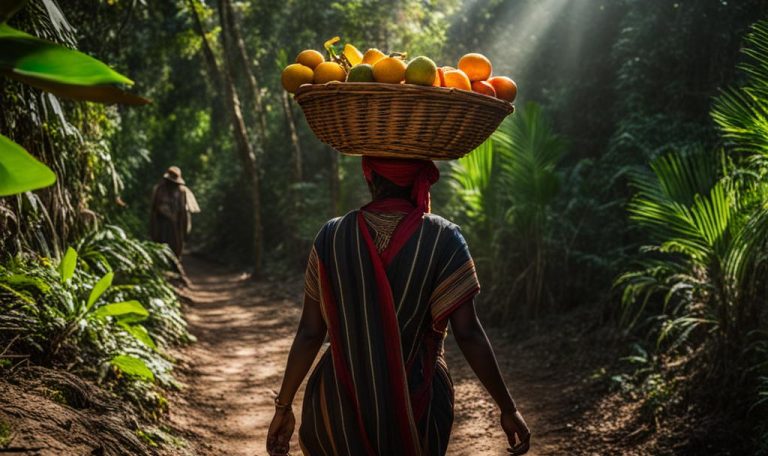Welcome to our exploration of the indigenous tribes in Panama, a country rich in cultural heritage and home to vibrant native communities. From the Guna (Kuna) people, known for their traditional garments called molas, to other indigenous groups, Panama offers a fascinating glimpse into the diverse indigenous cultures that have flourished for centuries.
Key Takeaways:
- Panama is home to diverse indigenous tribes with unique cultural traditions and practices.
- The Guna (Kuna) people are known for their intricate molas, traditional garments with deep cultural significance.
- Molas are handcrafted using the reverse appliqué technique and depict elements of nature.
- Mola-making has become a symbol of cultural resilience and is a source of economic empowerment for indigenous communities.
- Supporting indigenous communities is crucial for the preservation of cultural heritage and the recognition of indigenous rights.
The History and Significance of Molas in the Guna Community
The Guna (Kuna) people, an indigenous group residing in Panama and parts of Colombia, have a rich history of creating molas. Molas, meaning “shirt” in the Guna language, are traditional dresses worn by women. These vibrant garments are known for their intricate designs depicting flowers, animals, and other elements of nature. The art of making molas has been passed down through generations, preserving the cultural heritage of the Guna community.
The history of molas in the Guna community dates back centuries. Originally, the Guna people used body painting as a form of protection against evil spirits. Over time, these patterns were incorporated into fabric, giving birth to the unique art form of mola-making. The process involves reverse appliqué, where multiple layers of fabric are meticulously sewn together and carefully cut to reveal the design. Each mola is a labor-intensive masterpiece, representing the skill, creativity, and cultural significance of the Guna community.
Molas hold great importance in the Guna culture, symbolizing the community’s identity and connection to the natural world. The vibrant colors and intricate designs of molas reflect the beauty and diversity of their surroundings. They serve as a visual representation of the Guna people’s deep respect for nature and their ancestral heritage. The art of mola-making is not only a form of artistic expression but also a way for the Guna community to preserve their cultural traditions and pass them on to future generations.
The Cultural Significance of Molas
“Molas are not just beautiful garments; they are a tangible manifestation of our cultural identity and an expression of our love for our land and traditions.” – Guna Elder
| Key Aspects of Molas | Significance |
|---|---|
| Traditional Dress | Represent the Guna community’s unique identity and cultural heritage. |
| Intricate Designs | Depict natural elements and reflect the Guna people’s deep connection to nature. |
| Reverse Appliqué Technique | Showcase the craftsmanship and artistic skills of Guna women. |
| Symbol of Resistance | Preserve Guna traditions and resist assimilation by embracing and showcasing their cultural practices. |
Molas are not just garments; they are a source of cultural pride and resilience for the Guna people. The intricate designs, traditional techniques, and rich history behind molas make them a significant aspect of the Guna community’s cultural identity. By appreciating and supporting the art of mola-making, we can contribute to the preservation of indigenous cultures and celebrate the diversity and beauty of Panama’s cultural heritage.
The Craftsmanship and Techniques Behind Mola-Making
The art of mola-making showcases the incredible craftsmanship and artistic skills of the Guna women. This traditional technique involves a process called reverse appliqué, where multiple layers of fabric are sewn together and carefully cut to reveal the intricate design. The Guna women learn this technique from their mothers and grandmothers, passing down the knowledge and skills from one generation to the next.
Once the layers are sewn and cut, the Guna women use intricate embroidery by hand to add intricate details and bring the design to life. This meticulous attention to detail is what makes each mola a unique piece of art. The complexity of the design and the number of layers used in a mola reflect the skill and creativity of the artist.
Creating handmade garments like molas requires patience, precision, and a deep understanding of traditional techniques. The Guna women’s dedication to preserving their cultural heritage through mola-making is evident in the quality of their craftsmanship. Each mola is a testament to the Guna community’s artistic talents and their commitment to keeping their traditions alive.
| Techniques | Description |
|---|---|
| Reverse Appliqué | A process where multiple layers of fabric are sewn together and carefully cut to reveal the design. |
| Intricate Embroidery | Addition of detailed embroidery by hand to enhance the design and bring it to life. |
| Handmade Garments | Molas are meticulously handmade by Guna women, showcasing their artistic skills. |
| Traditional Techniques | The art of mola-making is passed down through generations, preserving traditional techniques and knowledge. |
The Cultural Resilience of the Guna People
The Guna people, an indigenous community in Panama, have displayed remarkable cultural resilience over the years. Despite the influence of modernization and external cultural pressures, the Guna people have remained steadfast in preserving their traditional practices and indigenous identity. Central to their cultural heritage is the esteemed tradition of mola-making, which serves as a symbol of their resilience and connection to their ancestors.
The mola tradition has been passed down through generations, with Guna women and girls learning the art of mola-making from their grandmothers and mothers. This handcrafted textile art involves the meticulous process of reverse appliqué, where multiple layers of fabrics are hand-sewn together to create intricate designs depicting elements of nature. Each mola is a unique masterpiece, reflecting the skill and creativity of the artist.
By continuing to create molas using traditional techniques and designs, the Guna people have exemplified their commitment to cultural preservation. The mola tradition serves as a tangible representation of their cultural resilience and an affirmation of their unique identity. In the face of changing times, the Guna community’s dedication to mola-making helps preserve their heritage and ensures that their traditions and cultural practices thrive for future generations.
“The mola tradition is deeply rooted in the Guna culture and serves as a means of cultural expression and resistance to assimilation.”
| Key Aspects of Guna Cultural Resilience |
|---|
| Maintaining traditional practices, such as mola-making |
| Preserving indigenous identity through cultural expressions |
| Passing down cultural traditions from one generation to the next |
| Sustaining cultural cohesion and connections to ancestors |
The cultural resilience of the Guna people demonstrates the importance of supporting indigenous communities and their efforts to preserve their heritage. By recognizing and valuing their traditional practices, such as mola-making, we can contribute to the empowerment and cultural preservation of the Guna community, ensuring the continued celebration of their vibrant culture and indigenous identity.
The Impact of Molas on Contemporary Panamanian Society
The art of mola-making has not only preserved the cultural heritage of the Guna community but has also made a significant impact on contemporary Panamanian society. Molas have become sought-after souvenirs for tourists visiting Panama, contributing to the local economy. Tourists can purchase authentic molas at various markets and stores, supporting the Guna women artisans who continue to make their own garments. The popularity of molas has also led to their inclusion in museum collections both in Panama and the United States, highlighting their artistic and cultural significance.

The art form of mola-making has become a source of pride and economic empowerment for the Guna community. By producing and selling molas, Guna women artisans have not only preserved their cultural traditions but also gained financial independence. This economic empowerment allows them to support their families, invest in education, and improve their quality of life. The mola market has created opportunities for sustainable livelihoods and has become an integral part of the Panamanian tourism industry.
Quotes:
“Molas are not just artistic creations; they are expressions of our cultural heritage. Through mola-making, we can share our traditions with the world and sustain our community.” – Guna artisan
“The demand for molas has opened doors for economic opportunities and cultural exchange. It has allowed us to showcase our indigenous art and connect with people from different parts of the world.” – Guna community leader
By supporting the mola market and appreciating the beauty and cultural significance of these intricate artworks, visitors and consumers contribute to the preservation of indigenous art forms and the empowerment of indigenous communities in Panama. This support helps ensure the continuation of mola-making as a cherished tradition and helps promote the preservation of indigenous cultural heritage for future generations to appreciate and celebrate.
| Mola Market Impact | Benefits |
|---|---|
| Economic Empowerment | Provides sustainable livelihoods for Guna women artisans |
| Cultural Preservation | Preserves indigenous art forms and traditional craftsmanship |
| Tourism Boost | Contributes to the local economy through increased tourism |
| International Recognition | Raises awareness of indigenous cultures on a global scale |
The Struggles for Indigenous Land Rights in Panama
Indigenous tribes in Panama, such as the Naso people, have long been fighting for their land rights and recognition. The Naso kingdom, in particular, has faced numerous challenges in securing their territory and preserving their cultural heritage. Despite winning the comarca, a collective-owned territory, in 2020, the Naso people continue to face demarcation challenges and the threat of deforestation.
The struggle for indigenous land rights in Panama highlights the ongoing need for support and resources to uphold the rights and autonomy of indigenous communities. The Naso lack the necessary resources to establish the borders of their territory, making it difficult to protect their land from encroachment. This puts their cultural practices, traditions, and environment at risk.
Preserving indigenous land rights is crucial not only for cultural preservation but also for biodiversity conservation and sustainable land management. The indigenous tribes of Panama have valuable knowledge and expertise in protecting the environment, which is essential for combating climate change and maintaining ecological balance. Collaboration between indigenous communities, governments, NGOs, and private funding groups is vital for supporting the recognition and preservation of indigenous land rights in Panama.
| Challenges | Impact |
|---|---|
| Demarcation challenges | Difficulty in protecting their land from encroachment |
| Deforestation | Threat to cultural practices, traditions, and environment |
Indigenous land rights are essential not only for the well-being of indigenous communities but for the overall diversity and sustainability of Panama. Recognizing the struggles faced by indigenous tribes and advocating for their rights and self-determination is a crucial step towards creating a more equitable and inclusive society.
Quote:
“Preserving indigenous land rights is not just about protecting the land but also safeguarding our cultural identity and the future of our communities.” – Indigenous activist
The Role of Indigenous Tribes in Conservation Efforts
Indigenous tribes in Panama play a crucial role in conservation efforts, contributing their deep knowledge and sustainable land management practices to protect biodiversity and combat climate change. With centuries of experience living in harmony with nature, indigenous communities possess valuable expertise that can help preserve and restore ecosystems.
These communities have a profound understanding of the interconnectedness between humans and the environment. Their traditional practices, passed down through generations, promote sustainable resource use and land stewardship. By utilizing indigenous knowledge and techniques, such as agroforestry and rotational farming, they promote the conservation of natural resources while ensuring the well-being of their communities.
Indigenous tribes also serve as guardians of significant biodiversity hotspots. Many indigenous lands in Panama are rich in unique flora and fauna, making them vital areas for conservation. Through their active resistance to the effects of colonization and their commitment to maintaining cultural cohesion, indigenous people have successfully protected these areas from exploitation. Collaboration with indigenous communities, governments, NGOs, and private funding groups is essential for supporting and amplifying their conservation work.
| Indigenous Knowledge | Sustainable Land Management | Protecting Biodiversity |
|---|---|---|
| Indigenous communities possess deep knowledge and understanding of their environments, passed down through generations. | Traditional practices, such as agroforestry and rotational farming, promote sustainable land use and resource management. | Indigenous lands often contain significant biodiversity hotspots that are protected by indigenous tribes. |
| By utilizing this knowledge, indigenous communities can contribute to conservation efforts and combating climate change. | Sustainable land management practices help preserve ecosystems and ensure the well-being of indigenous communities. | Collaboration with indigenous tribes is essential for protecting and preserving biodiversity. |
Cultural Practices and Oral Health of Indigenous Groups
Cultural practices play a significant role in the lives of indigenous groups in Panama, including the Ngäbe indigenous group. One such practice is tooth filing, a form of dental modification that holds cultural and symbolic importance for the Ngäbe people. Tooth filing involves altering the shape of the teeth as a means of self-expression and cultural identity.
The practice of tooth filing has been passed down through generations and is deeply rooted in Ngäbe traditions. While not every Ngäbe individual engages in tooth filing, it remains a significant cultural practice that showcases the uniqueness and resilience of the Ngäbe community. The art of tooth filing is a form of resistance against colonial influences, reflecting the Ngäbe people’s determination to preserve their cultural heritage.
While the impact of tooth filing on oral health may vary, understanding the socio-cultural context and traditions surrounding dental modification is crucial. It provides insights into the oral health practices and beliefs of indigenous groups in Panama. Exploring the connection between cultural practices and oral health allows for a comprehensive understanding of the indigenous communities’ overall well-being.
| Practice | Cultural Significance | Impact on Oral Health |
|---|---|---|
| Tooth Filing | Self-expression and cultural identity | Varies among individuals; may have protective benefits against dental decay based on ancient knowledge |
It is important to approach cultural practices with respect and understanding, recognizing their significance in the lives of indigenous communities. By acknowledging the cultural practices and beliefs surrounding oral health, we can foster a more inclusive and comprehensive approach to healthcare that respects and integrates indigenous traditions.
The Resilience of Indigenous People in Panama
Indigenous communities in Panama have demonstrated remarkable resilience in preserving their cultural cohesion, traditions, languages, rituals, and crafts. Despite the challenges posed by colonization and modernization, these communities have actively resisted assimilation and maintained their unique indigenous identity. Their commitment to cultural preservation is evident in the art form of mola-making, tooth filing, and other cultural practices passed down through generations.
Language plays a crucial role in maintaining cultural cohesion among indigenous groups in Panama. The preservation of indigenous languages is essential for the transmission of cultural knowledge and the expression of cultural identity. Through their rituals and ceremonies, indigenous communities reinforce their traditions and strengthen their collective bonds. These cultural practices serve as a testament to the resilience and determination of the indigenous people in Panama.

“Our traditions and crafts are the threads that bind us together as a community. They are our way of preserving our identity, honoring our ancestors, and passing on our cultural heritage to future generations.” – Elder from the Guna community.
The crafts produced by indigenous artisans, such as the intricately designed molas, are not only a means of cultural expression but also a source of economic empowerment. The sale of these crafts, both locally and to tourists, provides income for indigenous communities, helping to support their livelihoods and preserve their way of life. By recognizing the value of indigenous craftsmanship and supporting their economic endeavors, we can contribute to the continued resilience and cultural preservation of indigenous people in Panama.
Indigenous Resilience in the Face of Adversity
Despite centuries of adversity, indigenous people in Panama have shown remarkable resilience in preserving their cultural heritage. Through their commitment to traditions, languages, rituals, and crafts, they have defied attempts at assimilation and maintained their unique indigenous identity. By supporting and empowering these communities, we can help ensure the preservation of their rich cultural heritage and contribute to a more inclusive and diverse society.
The Importance of Supporting Indigenous Communities
Supporting indigenous communities in Panama is of utmost importance for the preservation of their cultural heritage, empowerment, and advocacy for their rights. By providing resources, recognition, and platforms for showcasing their artistic and cultural expressions, such as the intricate molas, we contribute to the preservation of their rich heritage and traditions.
Empowering indigenous communities goes beyond just providing them with the necessary resources. It involves recognizing their unique contributions and ensuring they have a voice in decision-making processes that affect their lives and territories. By supporting indigenous communities, we help amplify their advocacy efforts for land rights, cultural preservation, and environmental conservation.
“The culture and heritage of indigenous communities are invaluable assets, and it is our collective responsibility to protect and preserve them for future generations.” – [Your Name]
Advocacy plays a crucial role in ensuring that indigenous communities are heard, respected, and included in policy discussions and decision-making processes. It involves raising awareness about the challenges they face and mobilizing support to address these issues. Through advocacy, we can help create a more inclusive and equitable society that recognizes and values the diverse cultural identities and contributions of indigenous communities.
| Ways to Support Indigenous Communities | Benefits |
|---|---|
| Investing in education and healthcare | Empowering indigenous individuals with the knowledge and resources they need to thrive. |
| Supporting sustainable economic initiatives | Promoting economic empowerment within indigenous communities. |
| Preserving and promoting traditional crafts and practices | Ensuring the continuity of cultural traditions and providing economic opportunities for indigenous artisans. |
| Advocating for land rights | Protecting indigenous territories and preserving their connection to their ancestral lands. |
By supporting indigenous communities in Panama, we contribute to a more inclusive and vibrant society. Through cultural preservation, empowerment, resources, recognition, and advocacy, we can help create a future where indigenous traditions, knowledge, and voices are valued and celebrated.
Conclusion on Indigenous Tribes in Panama
The indigenous tribes in Panama possess a vibrant cultural heritage that is deeply intertwined with their land, traditions, and artistic expressions. From the intricate art of mola-making to their strong connection to nature, indigenous communities have demonstrated remarkable resilience in preserving their identity and cultural practices despite historical challenges.
To ensure the continued preservation of their rich cultural heritage, it is crucial for society to support indigenous communities in various ways. This includes recognizing and respecting their land rights, providing resources for cultural preservation, and collaborating in conservation efforts. By valuing and supporting indigenous tribes, we can contribute to the diversity and sustainability of Panama’s cultural landscape.
Furthermore, it is important to empower indigenous communities and amplify their voices in decision-making processes. By providing them with education, healthcare, and infrastructure, we can help create opportunities for their socioeconomic development and improve their overall well-being.
Ultimately, by supporting indigenous tribes in Panama, we can help safeguard their cultural heritage, protect their land rights, preserve the environment, and promote a more inclusive and equitable society. Let us celebrate the resilience of these communities and work together to create a future that embraces and honors their contributions. If you like these topics, feel free to regulary check our blog, follow our social media or download our app. You’d help the whole community with that.
FAQ
What are molas?
Molas are pieces of brightly colored clothing adorned with intricate designs, handcrafted by the Guna (Kuna) people of Panama. They hold deep cultural significance and are made using a technique called reverse appliqué.
What is the significance of molas in the Guna community?
Molas are a symbol of identity and connection to nature for the Guna community. They represent their cultural heritage and are passed down through generations, preserving their traditions and artistic skills.
How are molas made?
Molas are made through a process called reverse appliqué. Multiple layers of fabric are sewn together and carefully cut to reveal the intricate design. The final step involves intricate embroidery by hand, adding intricate details.
What is the cultural resilience of the Guna people?
The Guna people have actively resisted assimilation and maintained their cultural cohesion. The practice of mola-making is a testament to their resilience in preserving their traditions and cultural identity.
How have molas impacted contemporary Panamanian society?
Molas have become sought-after souvenirs for tourists, contributing to the local economy. They are also showcased in museums, highlighting their artistic and cultural significance.
What challenges do indigenous tribes face in securing their land rights in Panama?
Indigenous tribes, such as the Naso people, have faced challenges with demarcation and preventing deforestation. They lack resources to establish the borders of their territory, making it difficult to protect their land.
How do indigenous tribes contribute to conservation efforts?
Indigenous tribes have valuable knowledge and expertise in sustainable land management practices. Their active resistance to colonization and commitment to cultural cohesion have led to successful conservation efforts.
What is dental modification among indigenous groups in Panama?
Dental modification, such as tooth filing, is a cultural practice observed among some indigenous groups, like the Ngäbe. It serves as a form of cultural expression and resistance to colonial influences.
How have indigenous communities in Panama maintained their cultural traditions?
Indigenous communities have actively resisted assimilation and preserved their cultural practices, languages, rituals, and crafts over centuries. Their resilience is evident in their continued commitment to cultural preservation.
Why is it important to support indigenous communities in Panama?
Supporting indigenous communities is crucial for cultural preservation, empowerment, and advocacy. It helps preserve their heritage, provides them with resources, and promotes inclusivity and diversity in society.



